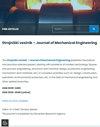Mixed Convection Heat Transfer in a Square Lid-Driven Cavity Filled with Al2O3-Water Nanofluid
IF 1.2
4区 工程技术
Q3 ENGINEERING, MECHANICAL
Strojniski Vestnik-Journal of Mechanical Engineering
Pub Date : 2017-06-06
DOI:10.5545/SV-JME.2017.4449
引用次数: 9
Abstract
This work is focused on the steady laminar mixed convection flow in a lid-driven square cavity filled with Al2O3 water-nanofluid using computational fluid dynamics. The top lid of the cavity was kept at a higher temperature in comparison with the bottom wall and moving at a constant speed while the left and right walls were kept insulated. Simulations were performed using Fluent ver. 6.3 where the water based nanofluid was considered as a single phase. A parametric study was conducted, and the effects of the Richardson number (0.1 ≤ Ri ≤ 10), the volume fraction of the nanoparticle (0 ≤ φ ≤ 0.04) on the fluid flow, and heat transfer inside the cavity were investigated. It was found that when (1 ≤ Ri ≤ 10) the average Nusselt number increases accordingly for the whole range of solid volume fraction of the nanofluid. The simulation results showed that the presence of nanoparticles in the base fluid increases the heat transfer rate. The variations of isotherm and streamline patterns inside the cavity with different volume fractions of nanoparticle and Richardson number were discussed and demonstrated.al2o3 -水纳米流体填充方形盖驱动腔的混合对流换热
本文利用计算流体动力学方法研究了Al2O3水纳米流体填充方形腔盖驱动下的稳定层流混合对流流动。与底壁相比,型腔的上盖保持较高的温度,并以恒定的速度移动,而左右壁保持绝缘。使用Fluent进行仿真。6.3其中将水基纳米流体视为单相。通过参数化研究,考察了理查德森数(0.1≤Ri≤10)、纳米颗粒体积分数(0≤φ≤0.04)对腔内流体流动和换热的影响。结果表明,当(1≤Ri≤10)时,纳米流体固体体积分数在整个范围内的平均努塞尔数相应增大。模拟结果表明,纳米颗粒的存在增加了基液的传热速率。讨论并论证了不同纳米颗粒体积分数和理查德森数对腔内等温线和流线模式的影响。
本文章由计算机程序翻译,如有差异,请以英文原文为准。
求助全文
约1分钟内获得全文
求助全文
来源期刊
CiteScore
3.00
自引率
17.60%
发文量
56
审稿时长
4.1 months
期刊介绍:
The international journal publishes original and (mini)review articles covering the concepts of materials science, mechanics, kinematics, thermodynamics, energy and environment, mechatronics and robotics, fluid mechanics, tribology, cybernetics, industrial engineering and structural analysis.
The journal follows new trends and progress proven practice in the mechanical engineering and also in the closely related sciences as are electrical, civil and process engineering, medicine, microbiology, ecology, agriculture, transport systems, aviation, and others, thus creating a unique forum for interdisciplinary or multidisciplinary dialogue.

 求助内容:
求助内容: 应助结果提醒方式:
应助结果提醒方式:


